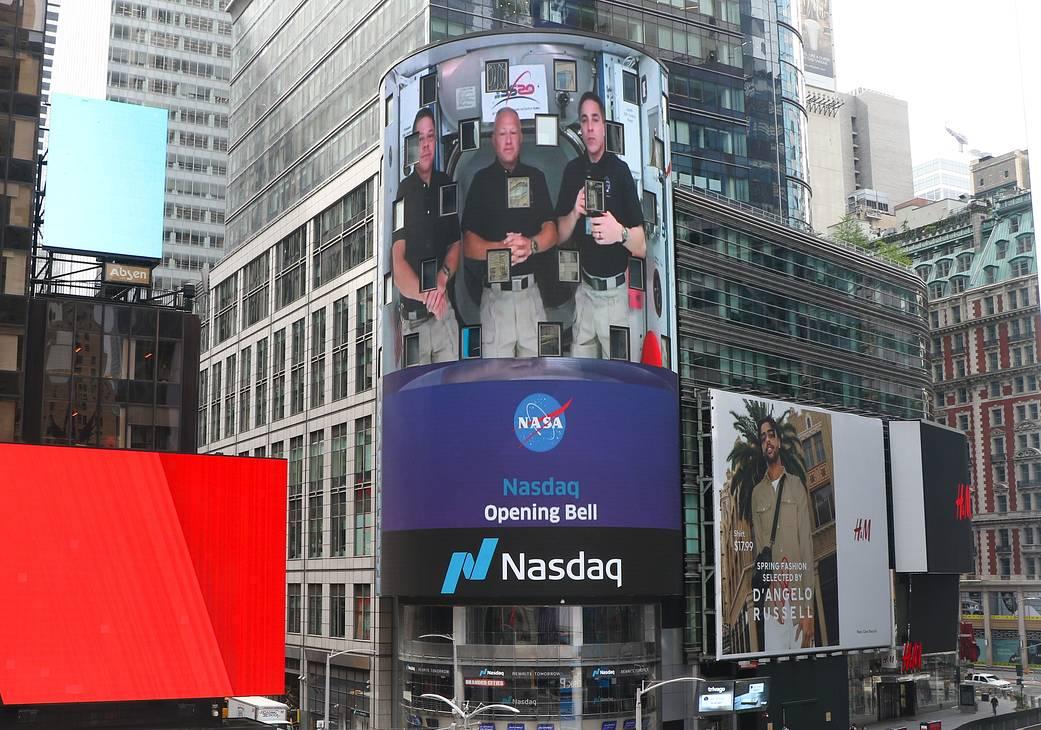
HOUSTON—The NASDAQ stock market’s opening bell sounded from the International Space Station (ISS) early June 2, a symbol of what the recently launched NASA/SpaceX Demo-2 flight to the orbiting science lab could mean for the future global space economy.
“It’s truly a critical moment in the development of the space economy and a new era of private human spaceflight,” declared Adena Friedman, the NASDAQ’s president and CEO, moments before ISS commander Chris Cassidy, joined by Demo-2 astronauts Doug Hurley and Bob Behnken, rang the bell in the station’s U.S. segment. That bell typically is rung to mark a change in command, a tradition that began nearly 20 years ago.
Earlier this year, the nonprofit Space Foundation placed the value of the global space economy at just under $415 billion for 2019 and on a trajectory to reach $1 trillion annually over the next two decades, while acknowledging challenges linked to the spread of the novel coronavirus pandemic and the social distancing response.
The May 30/31 launch and docking of the Demo-2 mission marked the first time humans have launched to orbit from the U.S. since NASA’s space shuttle fleet was retired in July 2011. It also marks a milestone in NASA’s bid to transition its oversight of human space activities in low Earth orbit to the private sector so that the agency can establish a sustained human presence on the Moon. Upon its planned lunar return in 2024, NASA is to join with U.S. commercial and international partners in learning to extract lunar resources and forge ahead to the human exploration of Mars in the 2030s.
While supporting those ambitions, nearly two decades of continuous staffing of the ISS has opened new commercial opportunities for high-value innovations such as the culturing of human retinal implants and other tissues for transplant, as well as the production of high-quality fiber optics. Each represents a potential improvement over what can be produced under the influence of gravity on Earth, said James Morhard, NASA’s deputy administrator, who joined the ceremony.
“We are really at the dawn of a new space age,” Morhard said. “It used to be that NASA developed, built, launched and operated spacecraft. Now we want the commercial industry to do just that in low Earth orbit.”
Ideally, NASA would be one of many commercial launch services customers, Morhard stressed.
The agency’s efforts to transition to commercial cargo deliveries to the ISS—now provided by SpaceX and Northrop Grumman Space Services—date back to early 2006. As the providers matured, NASA began the pursuit of a commercial crew launch concept in 2010 with SpaceX and Boeing. The latter company also is in flight testing, though months behind SpaceX.
“We think that the more people that get to fly to space, the better off we will be as a species,” Hurley told Friedman, noting the social ills many are experiencing on Earth linked to the pandemic and a struggling economy. “It’s really transformational when you come into space and look back at the planet to see how fragile it is. It really does change you for the better, and I think the more people we expose to this the better off we will be.”
“It’s what’s called the overview effect,” Behnken elaborated. “It’s what astronauts typically achieve when they accomplish their first spaceflight, look back at the Earth and realize there are no boundaries or borders observable from space for the most part. It’s our shared place in the universe.”
Cassidy also offered Friedman an optimistic technical assessment of the potential for future commercial human space travel as an underpinning for a growing space economy. He returned to the ISS for the second time aboard a Russian Soyuz rocket in April with cosmonauts Anatoly Ivanishin and Ivan Vagner for a planned six- to seven-month stay.
“We are really close technically. It’s not a leap at all,” Cassidy said. “It’s a matter of getting the will, getting the demand and we can make it happen. That is super exciting because there is so much capability that is offered here on the space station.”
Though currently limited to three full-time crew by its reliance on Soyuz crew transportation alone since the 2011 retirement of NASA’s shuttle fleet, the ISS can house up to seven crew. The U.S. segment includes pressurized research modules provided by the European and Japanese space agencies as well as NASA. In addition, the station’s solar power truss offers a range of external experiment platforms that can be accessed by astronauts on spacewalks or by using Canada’s robot arm.





